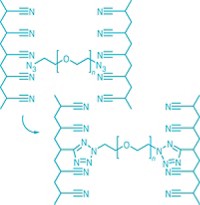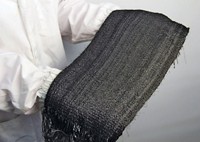Advertisement
Grab your lab coat. Let's get started
Welcome!
Welcome!
Create an account below to get 6 C&EN articles per month, receive newsletters and more - all free.
It seems this is your first time logging in online. Please enter the following information to continue.
As an ACS member you automatically get access to this site. All we need is few more details to create your reading experience.
Not you? Sign in with a different account.
Not you? Sign in with a different account.
ERROR 1
ERROR 1
ERROR 2
ERROR 2
ERROR 2
ERROR 2
ERROR 2
Password and Confirm password must match.
If you have an ACS member number, please enter it here so we can link this account to your membership. (optional)
ERROR 2
ACS values your privacy. By submitting your information, you are gaining access to C&EN and subscribing to our weekly newsletter. We use the information you provide to make your reading experience better, and we will never sell your data to third party members.
Biomaterials
Coating silk with carbon nanotubes yields electronic yarn by the yard
The durable, conductive yarn can be woven into washable sensors and smart fabrics
by Prachi Patel, special to C&EN
October 9, 2019

Using silk fibers coated with carbon nanotubes, researchers have spun tough, conductive yarn that can be knit or woven into wearable sensors and other electronic devices (Matter 2019, DOI: 10.1016/j.matt.2019.07.016). The yarn is water repellent and easy to make on a large scale.
Conductive silk could form the basis of wearable sensors for health and medical monitoring and degradable sensors for environmental monitoring. Smart motion-detecting textiles made from such fibers could allow users to interact with computers by interpreting gestures. “We think this technology could be competitive and lead to real-world applications of e-textiles,” says Markus J. Buehler, a civil and environmental engineer at the Massachusetts Institute of Technology.

Silk is one of the strongest and lightest natural materials; it’s also easily available, sustainable, and biocompatible. Silk has enticed engineers for years now as a material for flexible electronics. Some have made silk-based sensors and batteries that could dissolve inside the body. Researchers have made the naturally insulating fibers conduct electricity using various approaches, including mixing silk with conductive metal particles or carbon nanomaterials, or feeding silkworms graphene or carbon nanotubes.
Buehler, David L. Kaplan of Tufts University, Shengjie Ling of ShanghaiTech University, and their colleagues made their conductive silk yarn by dipping fibers from silkworm cocoons into a suspension of carbon nanotubes in hexafluoroisopropanol (HFIP). HFIP etches the surface of the silk fibers so that the nanotubes can bind with them and form an even coat.
Adding carbon nanomaterials to silk has been done many times before, but “the devil is usually in the details,” says Mostafa Bedewy, a mechanical engineer at the University of Pittsburgh who was not involved in this research. Other groups have tried dip-coating silk fibers, but the methods destroyed the silk fibers’ internal structure. HFIP is a toxic solvent, but it keeps the nanotubes from clumping together. The HFIP approach allows the researchers to load silk with a large number of nanotubes while maintaining the mechanical properties needed to process the yarn into textiles.
The researchers made kilometer-long strands of yarn by twisting the black nanotube-coated silk fibers together. The yarn could be machine washed without a noticeable change in conductivity. The team also wove the threads into textiles using a loom and embroidered the yarn into logo patterns with a sewing machine. Water poured on the textile rolls off the surface without wetting it.
The researchers demonstrated several potential applications for the material, creating a temperature sensor, force sensor, and a step counter out of the yarn. They also knitted the yarn into a glove that generated different electrical patterns based on the wearer’s hand gestures, hinting at future use as a sign language translation device.
The ability to make these conductive silk yarns and the demonstrated applications should accelerate their commercialization, Bedewy says. “This work bridges the gap between fundamental research and industry,” says Enzheng Shi, a chemical engineer at Purdue University.





Join the conversation
Contact the reporter
Submit a Letter to the Editor for publication
Engage with us on Twitter